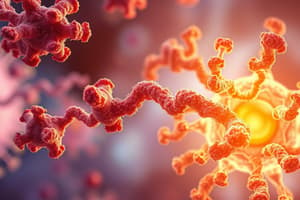Podcast
Questions and Answers
What are biological macromolecules?
What are biological macromolecules?
Large molecules, necessary for life, that are built from smaller organic molecules.
What are the four major classes of biological macromolecules?
What are the four major classes of biological macromolecules?
- Lipids (correct)
- Carbs (correct)
- Nucleic Acids (correct)
- Proteins (correct)
Define monomers.
Define monomers.
Single subunits, or building blocks.
What are polymers?
What are polymers?
What is metabolism?
What is metabolism?
What is dehydration synthesis?
What is dehydration synthesis?
What is hydrolysis?
What is hydrolysis?
What role do electrons play in dehydration synthesis and hydrolysis?
What role do electrons play in dehydration synthesis and hydrolysis?
What is the primary function of carbohydrates?
What is the primary function of carbohydrates?
Define monosaccharides.
Define monosaccharides.
What is a disaccharide?
What is a disaccharide?
Define polysaccharides.
Define polysaccharides.
What is the chemical formula for glucose?
What is the chemical formula for glucose?
Flashcards are hidden until you start studying
Study Notes
Biological Macromolecules
- Large molecules essential for life, constructed from smaller organic molecules that contain carbon.
- Often include hydrogen, oxygen, nitrogen, and trace elements.
Major Classes of Biological Macromolecules
- Four primary categories: carbohydrates, lipids, proteins, and nucleic acids.
Monomers
- Basic building blocks or single subunits that combine to form larger structures.
Polymers
- Formed when monomers link together via covalent bonds, creating larger macromolecules.
Metabolism
- Encompasses all chemical processes in a living organism to maintain life, including both catabolism (breaking down) and anabolism (building up).
Dehydration Synthesis/Anabolism
- Also known as condensation, this process builds polymers from monomers while releasing water as a byproduct.
- Involves the combination of hydrogen from one monomer with the hydroxyl group from another, creating covalent bonds and releasing water.
Hydrolysis/Catabolism
- A reaction that breaks down polymers into monomers using water.
- Involves a water molecule splitting, allowing one part to gain hydrogen and the other to gain a hydroxyl group.
Reactions of Dehydration and Hydrolysis
- Both reactions are catalyzed by specific enzymes and involve energy changes: dehydration builds bonds (requires energy), while hydrolysis breaks bonds (releases energy).
- Each reaction is specific to its respective class of macromolecules.
Role of Electrons in Reactions
- In dehydration synthesis, shared electrons between monomers form covalent bonds, stabilizing the structure while water is released.
Carbohydrates
- Serve as the primary energy source for the body, classified into three subtypes: monosaccharides, disaccharides, and polysaccharides.
- Follow the stoichiometric formula (CH2O)n, where the carbon, hydrogen, and oxygen ratio is 1:2:1.
Monosaccharides
- Simple sugars with a common structure, primarily glucose; carbon count ranges from three to seven.
- Typically end with the suffix -ose.
Disaccharides
- Formed when two monosaccharides undergo a dehydration reaction, resulting in a covalent glycosidic bond.
Polysaccharides
- Long chains created when multiple monosaccharides link together; examples include starch.
- Typically do not react with Benedict's reagent due to a lack of free aldehyde groups.
Glucose
- Chemical formula: C6H12O6; crucial as an energy source in the body.
- Classified as an aldose, it is one of the isomeric monosaccharides and belongs to the hexose category.
Studying That Suits You
Use AI to generate personalized quizzes and flashcards to suit your learning preferences.




